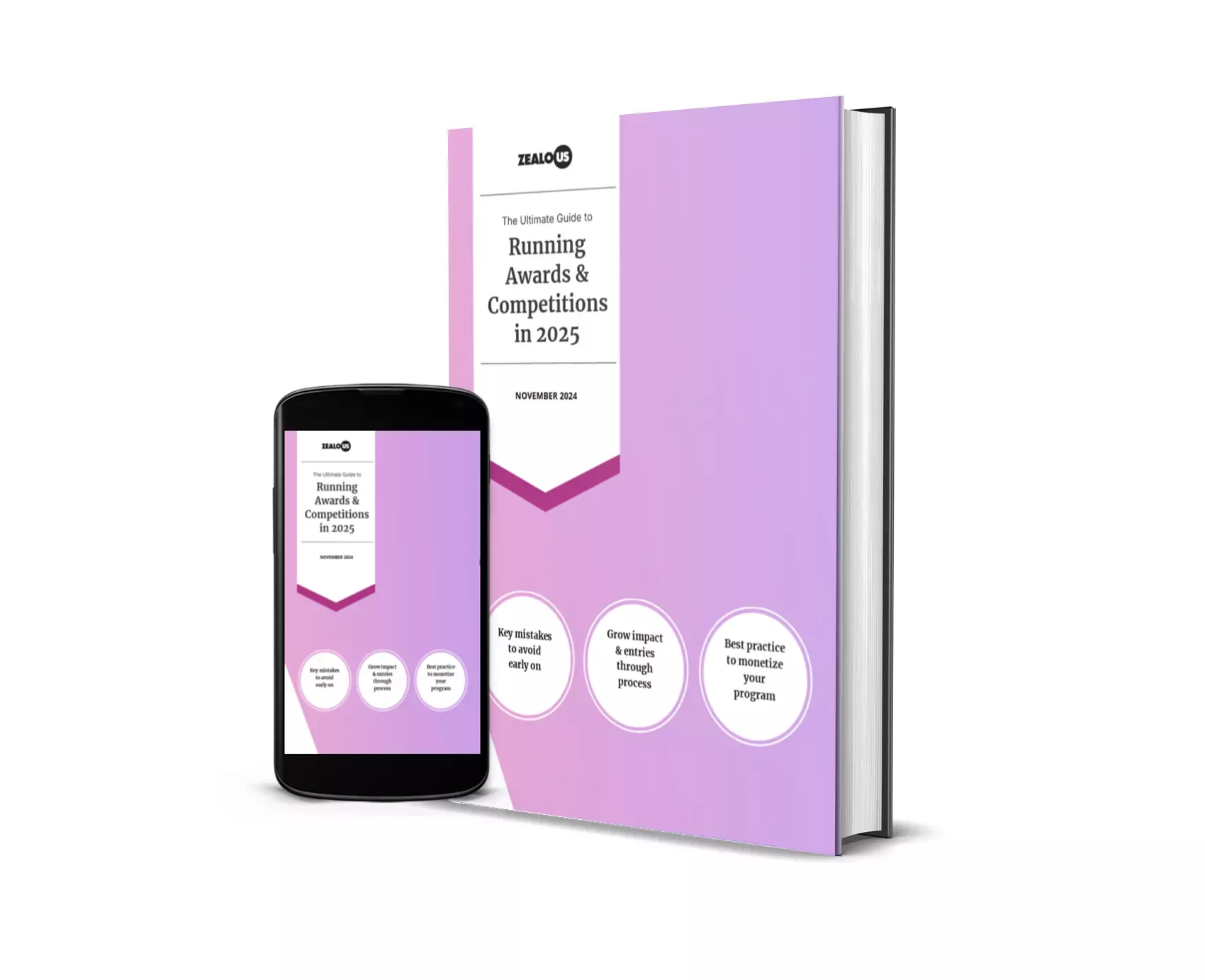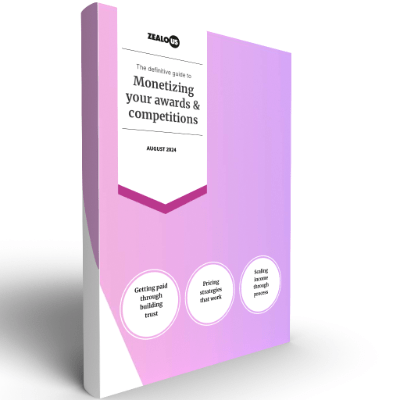This article covers:
Planning matters. You’ve spent months crafting your competition guidelines, setting clear deadlines, and building what you think is a watertight process.
But reality only hits when submissions open: candidates email asking questions already covered in your guidelines, technical issues surface at the worst possible times, and your inbox becomes an endless stream of “just checking if you received my entry.”
No amount of planning eliminates every issue. Candidates will encounter problems you never anticipated. What separates successful programmes from chaotic ones isn’t perfection in planning – it’s how effectively you field questions, create transparency, and stay available when things inevitably go sideways.
Clear communication channels by default
Your first submission will arrive with a question, or it might arrive and you might think – why did they submit that!). The question might be answered in your guidelines, buried in your FAQ, or nowhere at all because you never thought anyone would ask it.
Set up dedicated communication channels before submissions open.
A support email distinct from your general inbox keeps queries organised and trackable.
Time-saving tip
Create response templates for common scenarios: technical difficulties, missing information, deadline extensions, payment issues. Templates aren’t impersonal – they’re about responding quickly with consistent, accurate information whilst you’re managing hundreds of other tasks. Starting from a solid base saves 15 minutes per response.
FAQ as you go
Most organisations build their FAQ after receiving the same question 47 times. Smart ones update it as new patterns emerge (and save answering it 45 times!).
Start by mining previous competitions. What did people ask last time? If this is your first programme, review our guidelines on creating clear submission requirements and anticipate confusion points. Common FAQ topics include eligibility criteria, file format requirements, payment processes, judging timelines, and what happens after submission.
Update your FAQ weekly during the submission period. Noticed three people asking about video file formats? Add it immediately. The FAQ should live prominently on your submission page, not buried three clicks deep. Every question that reaches your inbox represents dozens of candidates who gave up without asking.
Your FAQ can also serve as evidence. When candidates claim “the guidelines weren’t clear,” you’ve got documentation showing exactly what information was available and when.
Download launch checklist
Never miss a critical step: 300+ tasks across 8 phases, from securing judges to winner announcement.
Create transparency around process and timing
Candidates want to know what happens after they hit submit. The silence that follows submission is anxiety-inducing. Did you receive it? Is something wrong with their files? When will they hear back? Did I overpay?
Send immediate automated confirmations. Not just “we received your submission” but actual detail: submission number, files received, payment confirmation if applicable, and crucially, what happens next with specific timeframes. Candidates who understand the process ask fewer questions and trust you more.
Your timeline should be specific enough to be meaningful. “You’ll hear from us in Spring” is useless. “Judging opens March 1st, winners announced by March 31st” gives people something concrete. If you need flexibility, build it in transparently: “Judging typically takes 4-6 weeks depending on submission volume.”
Red flag to watch for
Dashboard visibility is important. When candidates can log in and see their submission status – received, under review, judging in progress – you eliminate 60% of status update emails.
Automate everything (but not your humanity)
Manual processes hide in plain sight until submission volumes expose them. Sending individual confirmation emails. Manually tracking payment status. Copying scores from one system into another. Downloading entries to share with judges. Each takes two minutes, which means nothing until you’re doing it 200 times.
Calculate the cost
If handling submission queries takes 15 minutes per entry and you receive 400 submissions, that’s 100 hours of admin time. At even modest hourly rates, you’re spending thousands on tasks that could be automated. (and that’s before accounting for human error which is guaranteed to happen under stress, and compounds exponentially as volume increases).
Modern awards management platforms should handle routine tasks automatically: confirmation emails, payment processing and reconciliation, judge reminders, deadline notifications, and status updates.
The time saved frees you to handle the issues that actually need human judgment (and don’t worry there will be plenty of those!).
Prepare for the pre-deadline rush
Most submissions arrive in the final 72 hours before your deadline (we all do it!). This concentration creates predictable pressure points.
Staff your support channels heavily in the final week. Questions that took 24 hours to answer earlier need responses within an hour now. A candidate encountering a technical issue three days before deadline has time to work around it. The same issue six hours before deadline might cost you their submission entirely.
Technical infrastructure matters disproportionately during peak periods.
If your submission system crashes when 50 people try to upload simultaneously, you’ve just destroyed weeks of marketing effort and relationship building. Systems that have handled thousands of submissions without performance degradation aren’t lucky, they’ve been built just for this. If a platform vendor can’t tell you their peak concurrent user capacity, that’s a warning sign.
Consider extending deadlines strategically.
A 48-hour extension announced 24 hours before the original deadline gives stressed candidates breathing room and typically increases final submission numbers by 15-20%. The platform should let you extend deadlines with a single click whilst automatically notifying all registered users, not require you to manually update multiple pages and send individual emails.
Want more articles like this?
Give this one a like
Handle technical issues proactively
Technical problems follow patterns. Large video files. Unsupported formats. Browser compatibility. Slow uploads on mobile connections. Users forgetting passwords at critical moments.
Document workarounds for common issues and make them easily accessible. If video uploads consistently timeout over 2GB, either fix your infrastructure or clearly communicate the limitation upfront with specific recommendations (compress to H.264, use Vimeo embedding as alternative, etc.).
The phrase “it works for me” should be banned from your vocabulary, instead assume the issue exists and try and understand how the candidate is facing it to find the quickest workaround (and sometimes being on a different connection fixes things!).
Platforms with responsive support teams and genuinely unlimited file size capabilities eliminate entire categories of technical problems before they start.
If you can identify everything that can go wrong before the last minute surge, that’s a major win!
Manage candidate expectations consistently
Inconsistent communication breeds frustration and distrust. If you tell one candidate judging takes three weeks but another hears six weeks, you’ve created confusion and potential complaints.
Centralise your information. When your team members answer queries, they should reference the same documentation and provide consistent timelines.
This seems obvious until you’ve got five staff members improvising slightly different answers because nobody wrote down the official position (or worst, 3 versions of it exist).
Set realistic expectations, not optimistic ones.
Promising two-week turnarounds that become six weeks damages your reputation far more than honestly stating six weeks upfront. Build buffer time into every estimate. Judges get sick, unexpected submissions volumes require additional review rounds, technical issues cause delays. Your timeline should assume Murphy’s Law, not perfect conditions.
Track metrics that matter
Most programmes track submission numbers. Fewer track the data that helps them improve.
Monitor time-to-response on candidate queries. If support emails sit unanswered for three days during the submission period, you’re losing potential entries. Track common question themes to identify guideline weaknesses. If 30 people ask the same question, your guidelines need revision, not just another FAQ entry.
Some platforms will also allow you to see where in your process people drop out. Removing a few unnecessary questions from your form could make a big difference.
Submission abandonment reveals friction
Modern platforms show you where candidates start applications but don’t complete them. If 1,000 people begin but only 20 submit, something’s wrong. Perhaps your form is too long, file upload fails too often, or payment process creates unnecessary barriers (it could also be that they didn’t realise what they were submitting to!)
Track judge responsiveness once submissions close.
If judges consistently miss their review deadlines, your judging timeline was unrealistic or your judge selection needs work. Effective judging workflows include built-in reminder systems and progress tracking, so you spot problems early enough to intervene.
Insights like these straight to your inbox
Receive weekly tips from our founder to grow your program’s impact; regardless of what tools you use.
Design for mobile
Half your candidates will interact with your submission process on phones. They’ll read guidelines on their morning commute, check submission status during lunch breaks, and possibly complete entire applications from mobile devices (I wouldn’t, but some will!).
Forms designed for desktop computers can fail on mobile. Tiny text input boxes, image upload buttons that don’t work with phone cameras, multi-column layouts that become unreadable on small screens. If you haven’t tested your entire submission process on an actual phone, you’re losing mobile users.
Email communications must be mobile-optimised too. Support responses with desktop-formatted instructions and tiny screenshot attachments frustrate mobile users trying to follow along. Keep instructions simple, use large text, and assume candidates are reading on the smallest screens possible.
Build in flexibility without chaos
Rigid processes break when reality intervenes. A judge drops out two days before review starts. A technical issue affects a subset of submissions. A significant world event makes your original deadline insensitive (cough – COVID).
Modern platforms let you adjust deadlines, extend submission periods, add additional judges, and modify evaluation criteria without starting over (or paying more!).
But flexibility shouldn’t mean chaos. Document why you made changes, communicate them clearly to affected parties, and maintains audit trails showing exactly what changed and when.
Particularly important for growing programmes: your tools should scale without requiring complete rebuilds. If you can manage 50 submissions but the system breaks at 500, you’ve outgrown your infrastructure. Unlimited submissions and judges aren’t luxuries – they’re requirements for programmes that intend to grow over time.
Candidate experience is your competitive advantage
Your submission experience directly affects entry volume and quality. Candidates talk. They share horror stories about clunky systems, unresponsive administrators, and competitions that waste their time. They also recommend well-run programmes that respect their effort.
Professional, intuitive interfaces aren’t just about aesthetics – they build credibility. Candidates judge your entire organisation by the submission experience. A platform that looks like it was built in the 90s and handles like it too suggests you don’t value their time or your programme’s reputation.
You’ll know if your candidate experience will be good, based on your own. Quick platform setup matters more than people realise. You should be able to launch a competition in under an hour, not weeks. Templates and proven formats speed this up, but ultimately, intuitive design means you’re running your programme, not learning complex software. If you need to watch 70 tutorial videos, someone’s made this unnecessarily complicated. And it’s likely candidates will face the same issues.
Close the loop with all candidate
I used to think the submission was the end of the relationship – I was wrong – it’s the beginning. Unsuccessful candidates handle rejection well when it’s delivered with respect and context. Successful candidates become ambassadors when they feel genuinely celebrated.
Send personal rejection emails, not automated templates saying “unfortunately you weren’t selected.” If resources allow, provide brief feedback. Even something simple like “your concept was strong but execution needed more refinement” helps candidates understand the decision and improves future submissions.
Marketing your results effectively and tagging candidates benefits everyone.
Winners gain exposure, unsuccessful candidates see the quality bar they’re aspiring to, and your programme builds credibility for next year. A professional showcase gallery, winner announcements with proper photography, and celebration events all contribute to perceived programme value.
Learn from each round
Every programme offers lessons. The questions you answered repeatedly reveal guideline gaps. Technical issues that disrupted submissions highlight infrastructure weaknesses. Judge feedback about entry quality suggests requirement adjustments.
Debrief within two weeks of announcing winners, whilst memories are fresh. Involve everyone who touched the process: administrators, judges, support staff. What worked? What didn’t? What would you change? Document this immediately – you’ll forget critical details very quickly (and you’ll kick yourself for it once your new programme launches!).
Finally
Managing submissions effectively isn’t about preventing every possible problem. It’s about building systems that handle issues gracefully, communicate transparently, and respect everyone’s time – yours and your candidates’.
The difference between struggling through submission periods and managing them confidently often comes down to choosing the right tools. Spreadsheets and basic forms work until they don’t, usually at the worst possible moment. Purpose-built platforms eliminate categories of problems entirely whilst scaling effortlessly as your programme grows.
You’ve invested significant effort in creating opportunities that matter. The submission management process should amplify that effort, not undermine it with technical friction and administrative burden.
We can help!
Zealous makes running your programmes easier
But we’re not alone in the space – here are 8 others you may wish to consider (even if we would prefer you choose us!).
Want us to write more content like this? Give it a like
Share

Guy Armitage is the founder of Zealous and author of “Everyone is Creative“. He is on a mission to amplify the world’s creative potential.
Frequently Asked Questions
What’s the most common mistake when managing submissions?
Assuming your guidelines are clear just because you wrote them. Guidelines that make perfect sense to you may confuse candidates who lack your context.
The most successful programmes test guidelines with someone unfamiliar with the competition, then refine based on their questions. They also monitor incoming queries closely during the first week of submissions to catch confusion points early.
How much time should I allocate for submission management?
For every 100 submissions, budget approximately 15-20 hours of dedicated management time if you’re using manual processes with basic tools. This covers candidate queries, technical support, payment reconciliation, and judge coordination.
Modern submissions management platforms reduce this to 5-8 hours for the same volume by automating routine tasks, though you’ll still need time for complex queries and strategic decisions. The time investment doesn’t scale linearly—administrative burden per entry actually increases beyond 300 submissions without proper automation.
Should I use awards management software or stick with spreadsheets?
Spreadsheets seem cheaper initially but cost significantly more through manual processing time, human errors, poor candidate experience leading to dropout, and inability to scale effectively.
If you’re expecting fewer than 50 entries with simple requirements and no complex judging criteria, spreadsheets might suffice. Beyond that threshold, dedicated platforms pay for themselves immediately. Calculate the real hourly cost of manual work before assuming spreadsheets save money—they rarely do once you account for everyone’s time accurately.
How do I reduce last-minute submission panic?
Send progressive deadline reminders starting two weeks out, not just a final 24-hour warning. Communicate your support availability clearly so candidates know when they can get help. Consider soft deadlines for different submission components—requiring initial registration a week before final deadline gives you early visibility into potential volume.
Most importantly, ensure your technical infrastructure can handle peak loads. If your system crashes under pressure during the final rush, you’ve undermined months of work. Test capacity well before opening submissions.
What should I do when a candidate reports a technical issue?
Believe them. Respond within 2-3 hours during submission periods. Provide specific troubleshooting steps and alternatives. If the issue affects their ability to submit by the deadline, extend their personal deadline whilst investigating.
Document every technical issue reported—patterns reveal underlying problems requiring fixes. Never blame candidates for technical failures. Your job is removing barriers to entry, not defending your platform choices. If multiple candidates report the same problem, it’s definitely a real issue requiring immediate attention.
How can I tell if my submission process is actually working well?
Track completion rates—what percentage of people who start applications actually submit them? Strong processes see 70-80% completion rates. Monitor candidate query volume and themes. If you’re answering the same questions repeatedly, your process has communication gaps.
Survey candidates post-submission about their experience. Pay special attention to feedback about difficulty points and friction. Judge satisfaction matters too—if judges consistently complain about the review interface or missing information, that affects evaluation quality and their willingness to participate again.
When should I invest in proper awards management software?
Before you need it, honestly. Waiting until you’re drowning in manual processes means you’re either running a lower-quality programme than you could be or you’re burning out your team.
If you’re planning any competition expecting over 100 entries, evaluating platforms should be part of your initial planning, not something you consider after a painful first year. Exploring available features and capabilities early helps you understand what’s actually possible and prevents you from building processes around tool limitations rather than your actual needs.









